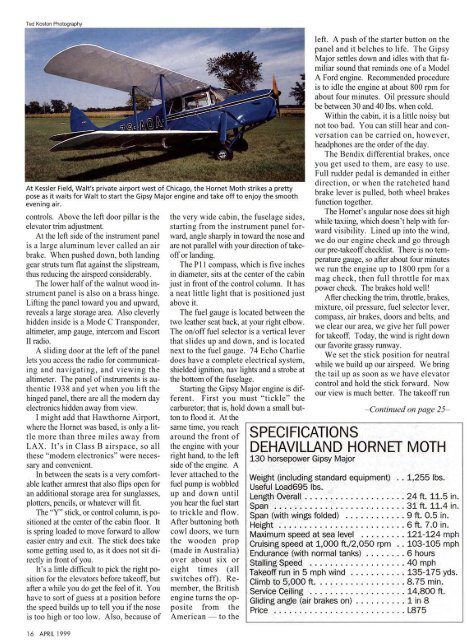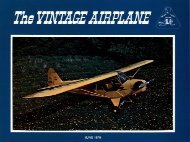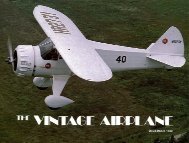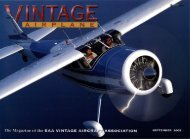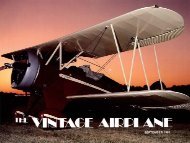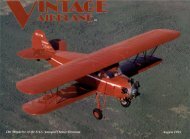VA Vol 27 No 4 April 1999 - Members Only
VA Vol 27 No 4 April 1999 - Members Only
VA Vol 27 No 4 April 1999 - Members Only
Create successful ePaper yourself
Turn your PDF publications into a flip-book with our unique Google optimized e-Paper software.
At Kessler Field, Walt's private airport west of Chicago, the Hornet Moth strikes a pretty<br />
pose as it waits for Walt to start the Gipsy Major engine and take off to enJoy the smooth<br />
evening air.<br />
controls. Above the left door pillar is the<br />
elevator trim adjustment.<br />
At the left side of the instrument panel<br />
is a large aluminum lever called an air<br />
brake. When pushed down, both landing<br />
gear struts turn flat against the slipstream,<br />
thus reducing the airspeed considerably.<br />
The lower half of the walnut wood instrument<br />
panel is also on a brass hinge.<br />
Lifting the panel toward you and upward,<br />
reveals a large storage area. Also cleverly<br />
hidden inside is a Mode C Transponder,<br />
altimeter, amp gauge, intercom and Escort<br />
II radio.<br />
A sliding door at the left of the panel<br />
lets you access the radio for communicating<br />
and navigating, and viewing the<br />
altimeter. The panel of instruments is authentic<br />
1938 and yet when you lift the<br />
hinged panel, there are all the modem day<br />
electronics hidden away from view.<br />
I might add that Hawthorne Airport,<br />
where the Hornet was based, is only a little<br />
more than three miles away from<br />
LAX. It's in Class B airspace, so all<br />
these "modern electronics" were necessary<br />
and convenient.<br />
In between the seats is a velY comfortable<br />
leather armrest that also flips open for<br />
an additional storage area for sunglasses,<br />
plotters, pencils, or whatever will fit.<br />
The "Y" stick, or control column, is positioned<br />
at the center of the cabin floor. It<br />
is spring loaded to move forward to allow<br />
easier entry and exit. The stick does take<br />
some getting used to, as it does not sit directly<br />
in front of you.<br />
It's a little difficult to pick the right position<br />
for the elevators before takeoff, but<br />
after a while you do get the feel of it. You<br />
have to sort of guess at a position before<br />
the speed builds up to tell you if the nose<br />
is too high or too low. Also, because of<br />
16 APRIL <strong>1999</strong><br />
the very wide cabin, the fuselage sides,<br />
starting from the instrument panel forward,<br />
angle sharply in toward the nose and<br />
are not parallel with your direction of takeoff<br />
or landing.<br />
The P 11 compass, which is five inches<br />
in diameter, sits at the center of the cabin<br />
just in front of the control column. It has<br />
a neat little light that is positioned just<br />
above it.<br />
The fuel gauge is located between the<br />
two leather seat back, at your right elbow.<br />
The onlofffuel selector is a vertical lever<br />
that slides up and down, and is located<br />
next to the fuel gauge. 74 Echo Charlie<br />
does have a complete electrical system,<br />
shielded ignition, nav lights and a strobe at<br />
the bottom of the fuselage.<br />
Starting the Gipsy Major engine is different.<br />
First you must "tickle" the<br />
carburetor; that is, hold down a small but<br />
ton to flood it. At the<br />
same time, you reach<br />
around the front of<br />
the engine with your<br />
right hand, to the left<br />
side of the engine. A<br />
lever attached to the<br />
fuel pump is wobbled<br />
up and down until<br />
you hear the fuel start<br />
to trickle and flow.<br />
After buttoning both<br />
cowl doors, we turn<br />
the wooden prop<br />
(made in Australia)<br />
over about six or<br />
eight times (all<br />
switches off) . Remember,<br />
the British<br />
engine turns the opposite<br />
from the<br />
American - to the<br />
left. A push of the starter button on the<br />
panel and it belches to life. The Gipsy<br />
Major settles down and idles with that familiar<br />
sound that reminds one of a Model<br />
A Ford engine. Recommended procedure<br />
is to idle the engine at about 800 rpm for<br />
about four minutes. Oil pressure should<br />
be between 30 and 40 Ibs. when cold.<br />
Within the cabin, it is a little noisy but<br />
not too bad. You can still hear and conversation<br />
can be carried on, however,<br />
headphones are the order of the day.<br />
The Bendix differential brakes, once<br />
you get used to them, are easy to use .<br />
Full rudder pedal is demanded in either<br />
direction, or when the ratcheted hand<br />
brake lever is pulled, both wheel brakes<br />
function together.<br />
The Hornet's angular nose does sit high<br />
while taxiing, which doesn't help with forward<br />
visibility. Lined up into the wind,<br />
we do our engine check and go through<br />
our pre-takeoff checklist. There is no temperature<br />
gauge, so after about four minutes<br />
we run the engine up to 1800 rpm for a<br />
mag check, then full throttle for max<br />
power check. The brakes hold well!<br />
After checking the trim, throttle, brakes,<br />
mixture, oil pressure, fuel selector lever,<br />
compass, air brakes, doors and belts, and<br />
we clear our area, we give her full power<br />
for takeoff. Today, the wind is right down<br />
our favorite grassy runway.<br />
We set the stick position for neutral<br />
while we build up our airspeed. We bring<br />
the tail up as soon as we have elevator<br />
control and hold the stick forward. <strong>No</strong>w<br />
our view is much better. The takeoff run<br />
- Continued on page 25<br />
SPECIFICATIONS<br />
DEHAVILLAND HORNET MOTH<br />
130 horsepower Gipsy Major<br />
Weight (including standard equipment) .. 1,255 Ibs.<br />
Useful Load695 Ibs.<br />
Length Overall .................... 24 ft. 11.5 in.<br />
Span .......................... 31 ft. 11.4 in.<br />
Span (with wings folded) ............ 9 ft. 0.5 in.<br />
Height ......................... 6 ft. 7.0 in.<br />
Maximum speed at sea level ......... 121-124 mph<br />
Cruising speed at 1,000 ft./2,050 rpm .. 103-105 mph<br />
Endurance (with normal tanks) ........ 6 hours<br />
Stalling Speed ................... 40 mph<br />
Takeoff run in 5 mph wind ........... 135-175 yds.<br />
Climb to 5,000 ft.................. 8.75 min.<br />
Service Ceiling ................... 14,800 ft.<br />
Gliding angle (air brakes on) .......... 1 in 8<br />
Price .......................... L875


